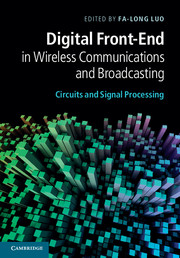Book contents
- Frontmatter
- Contents
- Contributors
- Preface
- Part I Introduction to digital front-end
- 1 Introduction to wireless communications and digital broadcasting
- 2 Basic principles and protocols of digital wireless communications
- 3 Digital front-end and system overview in wireless communication
- 4 System overview and front-end technologies in digital broadcasting
- 5 Digital front-end for multiple standards and multimode compatibility
- Part II DPD and CFR
- Part III DUC, DDC, ADC, DAC, and NCO
- Part IV Digital calibration, imbalance compensation, and error corrections
- Part V Circuits and system integration in digital front-end
- Index
- References
3 - Digital front-end and system overview in wireless communication
from Part I - Introduction to digital front-end
Published online by Cambridge University Press: 07 October 2011
- Frontmatter
- Contents
- Contributors
- Preface
- Part I Introduction to digital front-end
- 1 Introduction to wireless communications and digital broadcasting
- 2 Basic principles and protocols of digital wireless communications
- 3 Digital front-end and system overview in wireless communication
- 4 System overview and front-end technologies in digital broadcasting
- 5 Digital front-end for multiple standards and multimode compatibility
- Part II DPD and CFR
- Part III DUC, DDC, ADC, DAC, and NCO
- Part IV Digital calibration, imbalance compensation, and error corrections
- Part V Circuits and system integration in digital front-end
- Index
- References
Summary
Introduction
With the software defined radio (SDR) concept a new communication technology was created to improve interoperability among different wireless networks, systems, and devices and some of the typical limitations in flexibility of classical radio implementations were removed, aiming at the same time at reducing the cost of technology components. For example, in a classical radio implementation, some hardware components like filters are required to cancel unwanted emissions, but good analog filters are costly and inflexible. Instead, an SDR can be considered a wireless system whose main functionality and operational parameters, like output power, frequency band, air interface including modulation techniques, security and performance characteristics, are implemented by means of software programs running on programmable devices that can dynamically reconfigure the system. In such a way there is the possibility to create multimode, multiband, and multi-functional network equipment that can be reconfigured, enhanced, and upgraded during their operation through software updates and hardware reconfiguration, instead of physical changes in the hardware. As detailed in the sections below, standards for wireless communications include adaptive modulation and coding, as well as scalable bandwidths and transmit power control. These facts require, both in user terminals and in base-stations, a degree of flexibility and re-configurability, software upgrading, and multimode-multiband compliance. Besides, some access techniques, especially CDMA, are very sensitive to precise frame synchronization. Software defined radio is a suitable tool to overcome issues like these.
This chapter is organized into five sections. In the rest of this section, we will give a brief introduction to digital front-end and its key processing units. Section 3.2 is devoted to presenting new objectives and technologies for transmission and reception of modern wireless communication systems with emphasis on the front-end part. In particular, this section introduces some recent mobile communications standards, suitable for SDR developments because of their novelty and capability of reconfiguration. Also, an overview of the fundamentals of the main access techniques is presented, and the key terminology and most relevant parameters are also provided. There are a considerable number of abbreviations used in modern wireless communication systems, and this is unavoidable. In Section 3.3, emerging broadband wireless standards are reviewed. This includes the standards in development under the umbrella of the IMT-Advanced Program, as well as some new standards including some that are based on cognitive radio strategies. Section 3.4 focuses on some considerations on how to design and implement DFE, covering transceiver and related power amplifier, chip circuit and its implementation platform as well as some technological comments. Finally, Section 3.5 summarizes and concludes.
- Type
- Chapter
- Information
- Digital Front-End in Wireless Communications and BroadcastingCircuits and Signal Processing, pp. 50 - 97Publisher: Cambridge University PressPrint publication year: 2011
References
- 1
- Cited by



